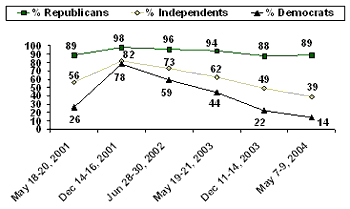GALLUP NEWS SERVICE
PRINCETON, NJ -- President George W. Bush's tumbling job approval ratings have quickly become the major focus of recent news coverage of this year's presidential election. There is a good reason for this intense interest -- job performance ratings are a key indicator of re-electability for an incumbent in any office.
The problem for Bush rests with the fact that a majority of Americans now gives a negative evaluation of his performance in office. That obviously has lowered the probability of his re-election in November.
Yet the election is still 5 1/2 months away. Bush campaign officials hold out the expectation -- at least according to their public comments -- that Bush's fortunes will rebound. White House Communications Director Dan Bartlett was quoted in the Washington Times Tuesday: "Polls are a snapshot in time . . . We believe we are on the right path of success. And as that starts to take root and the public starts seeing those things, we think his standing with the public will improve as well." Although, in an apparent burst of candor, Republican National Committee Chairman Ed Gillespie was quoted in the same article as saying: "We'd rather be up than down."
It's certainly possible that Bush's job approval ratings will change, and perhaps change substantially between now and November. His ratings have by no means followed a straight-line path during his three-plus years in office so far. Bush began his term in office with job approval ratings in the mid-50% range, about the average level for all presidents in the modern era. From Sept. 11, 2001, on, his ratings have essentially undergone three upward surges:
- shortly after the Sept. 11 terrorist attacks (an unprecedented increase of about 40 percentage points)
- at the beginning of the war in Iraq in March 2003 (an increase of about 14 points)
- in November through December 2003, coincident with Bush's surprise visit to Iraq and the capture of former Iraqi leader Saddam Hussein (an increase of about 13 points)
Bush's ratings have dropped after each of these surges -- not surprisingly, as it is difficult for any president to sustain high job approval ratings for extended periods of time in a highly partisan political environment. Unfortunately for Bush, the fade this time has continued to the point where his approval rating is now at 46%, the lowest of his administration, and well below the 50% threshold to be desired by an incumbent seeking re-election.
Where will Bush's ratings go from this point?
Bush campaign strategist Matthew Dowd contends that Bush has reached a floor of sorts in his ratings because Bush has continually enjoyed high levels of support from Republicans. Since Republicans constitute about a third of the U.S. population, it is mathematically correct to assume that a 90% job approval rating from this group, coupled with some level of approval from independents and Democrats, will result in an overall rating in the 40% range.
Here is a graph that presents the breakout of Bush's job approval at various points in his administration:
| George W. Bush's Job Approval
Ratings by Partisanship Selected Trend 2001-2004 |
 |
It's clear that Bush's job approval rating among Republicans has remained remarkably high during his entire administration. Bush started in the first months of 2001 with about 9 in 10 Republicans approving of the job he was doing. Then, coincident with record-high overall approval ratings after 9/11, Bush's approval among Republicans zoomed to almost 100%. As Bush's overall ratings slipped, his approval dropped back a little to roughly the 90% level among Republicans, but no further. Remarkably, his job approval rating among Republicans has remained at that level ever since. At the same time, Bush has lost support among both independents and Democrats. In Gallup's most recent poll, in fact, Bush's job performance is approved of by only 14% of Democrats.
How tenable is the Bush campaign's contention that the president's ratings will not drop further because of the rock-solid support he is getting among his own party base?
One way to attempt to answer that question is to look at the records of the last six presidents who sought re-election -- three of whom succeeded and three of whom did not.
These graphs represent the job approval ratings within party for each of these presidents in May of their election years.
| Presidential Approval by
Partisanship Trend for May of Each Re-Election Year |
 |
| Presidential Approval by
Partisanship Trend for May of Each Re-Election Year |
 |
One obvious conclusion from a consideration of these data: Anything is possible.
Of the six most recent presidents who have sought re-election, the three who were re-elected (Bill Clinton, Ronald Reagan, and Richard Nixon) all had partisan job approval ratings (that is, job approval ratings among members of their own parties) in May of their election years that were very similar to Bush's current pattern -- 85% or higher.
Clinton, Reagan, and Nixon all had higher overall job approval ratings than Bush because they enjoyed higher levels of support among independents and members of the opposite party. Note, for example, that Reagan received 32% approval rating from Democrats in May 1984, some 18 points higher than the current president receives among Democrats today.
The three presidents who lost (George H.W. Bush, Jimmy Carter, and Gerald Ford) all had partisan job approval ratings that were quite a bit lower. Bush's father had only a 70% approval rating among Republicans in May 1992, Carter had only a 55% approval rating among Democrats in May 1980, and Ford had only a 64% approval rating among Republicans in May 1976.
Still, despite these low partisan numbers, Bush the elder, Carter, and Ford for the most part had higher approval ratings among independents and members of the opposite party than Bush does now.
These patterns reinforce the conclusion that the current president is currently maneuvering in a zone that does not fit the precise patterns of any of these six previous presidents who ran for re-election. He is enjoying the same type of partisan strength as winning incumbents in the past, but does not have the strength among independents and members of the opposite party that even unsuccessful incumbents had.
Bush strategists would argue that Bush's ability to hold on to 90% support among Republicans is a good sign, and that he will go back up among independents and Democrats in the weeks ahead, bringing his job approval rating back above 50%. If so, Bush's approval pattern would begin to more closely model the pattern established in the 1996, 1984, and 1972 races by Clinton, Reagan, and Nixon, respectively.
On the other hand, the data certainly suggest that it is also possible for Bush to lose support among members of his own party -- as happened in the case of his father, Carter, and Ford. If that happens, the current president's already low standing among Democrats and independents would mean that Bush's overall job approval rating would fall even further. The nadir for the president, of course, would be if he ended up in the same situation as his father in the summer of 1992, when at one point the elder Bush had only 64% approval among Republicans, 27% among independents, and 12% among Democrats.
Thus, one key indicator in this election will be Bush's ability to hold on to his Republican base while at the same time increasing his standing, at least moderately, among independents and Democrats.
It's unclear, however, how successful Bush can be in getting a jump-start in his ratings among independents and Democrats.
Regardless of campaign efforts or real world events, it's unlikely we will see another increase of 40 points or more in Bush's approval rating (as happened in September 2001). A jump of 13 points, as happened last fall, is a more reasonable possibility, but would probably be contingent upon some major international event (such as a successful handover of control in Iraq on June 30 or the capture of Osama bin Laden).
Survey Methods
Results are based on telephone interviews with 1,003 national adults, aged 18 and older, conducted May 7-9, 2004. For results based on the total sample of national adults, one can say with 95% confidence that the margin of sampling error is ±3 percentage points. For results based on the 504 national adults in the Form A half-sample and 499 national adults in the Form B half-sample, the maximum margins of sampling error are ±5 percentage points. In addition to sampling error, question wording and practical difficulties in conducting surveys can introduce error or bias into the findings of public opinion polls.
